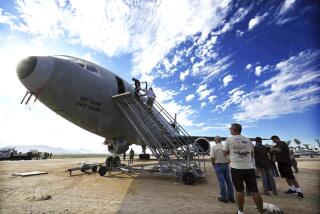Girl’s Plane Was Overloaded on Takeoff, Investigator Says
- Share via
HALF MOON BAY, Calif. — The single-engine Cessna carrying 7-year-old Jessica Dubroff on a cross-country flight was over its takeoff weight when it crashed in a storm near the Cheyenne, Wyo., airport, killing all aboard, a federal investigator said Friday.
Cheyenne’s 6,000-foot elevation, coupled with the excess weight, could have had a crucial impact on the performance of the Cessna 177B Cardinal in which Jessica, her father and her flight instructor perished, said Steve McCreary of the National Transportation Safety Board.
“What we’re talking about is an airplane that has exceeded its maximum gross takeoff weight at an airport that is above sea level,” McCreary told a news conference in Greeley, Colo., where the wreckage was taken for examination after Thursday’s crash. “Those conditions are going to degrade the performance of the aircraft.”
While many continued Friday to question the decision to let Jessica attempt to become the youngest person to pilot a plane cross-country, her mother appeared on television to defend the flight and also visited the Cheyenne neighborhood where the plane smashed into the ground.
“You have no idea what this meant to Jess,” said Lisa Blair Hathaway on NBC’s “Today” show, crying and cradling her 3-year-old daughter Jasmine. “I did everything so this child could have freedom and choice and have what America stands for. Liberty comes from . . . just living your life. I couldn’t bear to have my children in any other position.”
Later in the day, Hathaway spoke briefly at the crash site where well-wishers had placed flowers, teddy bears and other mementos. She said the coroner had told her that when the bodies were removed, the arm of Jessica’s father, Lloyd Dubroff, was around his daughter. “She wanted to die with her father . . . she said that long before she flew,” Hathaway said. “So she got that.”
The body of flight instructor Joe Reid, who made the decision to take off amid near-freezing rain and an impending thunderstorm, was thrown from the plane on impact, Coroner Bill Ryan said.
McCreary said no evidence has been found of a mechanical malfunction, but added that the investigation could continue for six months or longer. “We are still very early on in the investigation,” he said.
Another pilot who took off minutes before Jessica’s plane reported that he encountered wind shear, a sudden shift in wind direction, McCreary said. After controllers gave clearance for takeoff, there was no further communication with Jessica’s plane, he said.
Jessica and Reid’s hands were examined to determine who might have been flying the plane, McCreary said. Jessica’s hands had a few minor fractures and Reid’s hands and arms had major fractures. But McCreary said they have yet to determine who was piloting the plane at the time of the crash. The plane was equipped with dual controls.
Here at the small Northern California airport where Jessica took flying lessons, those who knew Reid said it was “even chance” that Jessica was piloting the plane when it took off.
“Joe was the kind of instructor who gave his students, even young ones like Jessica, a lot of control,” said Forrest Storz, the only other flight instructor at the Half Moon Bay Airport. “He felt that it was the only way they were going to learn.”
Storz said Jessica received all the training that any adult student with 35 hours of flying time would receive. He watched her take off and land numerous times without a hitch since she took up flying four months ago. He said Jessica knew how to negotiate all the turns and how to recover when a plane stalls. “Her [landing] patterns were typically quite good,” he said.
But Storz did acknowledge that her airport-to-airport experience was limited to short flights to nearby San Carlos and Palo Alto. “This cross-country trip was the most ambitious undertaking in terms of distance,” he said. “But I don’t think it was out of the ordinary.”
Other flight instructors throughout the state disagreed, saying that 35 flying hours in no way prepared Jessica, much less an adult student, for the rigors of a flight across the United States.
“An adult with 35 hours is just about ready for a 100-mile trip,” said John Vandervort, a Santa Monica flight instructor. “In Jessica’s case, they were going to go 7,000 miles. That’s not a training event. That’s an adventure. An adult adventure.”
In Washington, Federal Aviation Administration chief David Hinson repeated his position that Jessica’s age was not an issue because Reid was in charge of flying the plane and deciding whether it was safe to take off or to let Jessica, as an unlicensed passenger, take the controls. “We hold the pilot in command, in this case, Mr. Reid, totally responsible,” Hinson said.
But Senate Commerce Committee Chairman Larry Pressler (R-S.D.), whose panel oversees the agency, called Jessica’s quest for the record “irresponsible competition” and said it might have been encouraged by the lack of FAA rules on the minimum age to fly an aircraft. “It would appear the FAA does not require any minimum age for a person to fly an aircraft, provided a certified pilot is on board and available to take instantaneous control of the aircraft,” Pressler said. “Does the lack of a minimum age encourage this kind of irresponsible competition?”
Aircraft industry groups are criticizing the trend of younger and younger children in the pilot’s seat.
“Long ago someone told me that flying was hours and hours of sheer boredom punctuated by moments of stark terror,” said Bob Vandel, a director of the Flight Safety Foundation in Virginia. “Now what does a 7-year-old do in that moment of stark terror. What experience do they have to base their emergency response on?”
Others in the aviation field, while acknowledging that the final decision was Reid’s, speculated that the pressure to establish a record--even one not recognized by official bodies or even the Guinness Book of World Records--may have contributed.
“The competition coupled with the publicity puts the child and flight instructor under a lot of scheduling pressures that don’t exist in normal flights,” said Drew Steketee of the Aircraft Owners and Pilots Assn. ‘We’re hoping this tragedy ends the competition to be the youngest to fly across the country.”
Experts in human behavior have mixed feelings about whether a 7-year-old is intellectually capable of flying an airplane.
“The general answer is not as clear-cut as one would want,” said psychologist Norman Krasnegor of the National Institute of Child Health and Human Development. Some of the intellectual qualities necessary for piloting are certainly present at that age, while others may not be, and simply stating that a person is 7 does not give a complete picture of their abilities, said Krasnegor, chief of the institute’s Human Learning and Behavior Branch.
Krasnegor cites the example of young chess prodigies who must juggle 50 or 60 potential moves in their heads to suggest that children have the ability to make complex decisions such as those required to fly a plane. And they also are able to handle stress, he notes.
“There is probably a great deal of pressure in a grandmaster chess match, but is that the same as flying a plane in a hailstorm? I can’t answer that,” he said. “But I can say that there can be tremendous intellectual capacity at an early developmental stage, even though most people, when asked, would say no.”
But the difference between chess and flying a plane is that “it doesn’t endanger anybody if a child loses a chess match,” said developmental neurobiologist Paschko Rakic of Yale University.
Rakic concedes that a 7-year-old can certainly manipulate the controls, perhaps even take off and land. “But flying is not just putting the airplane up and down,” he said. “It is a question of judgment, of what the consequences are for each decision. [A 7-year-old] cannot recognize the consequences. She doesn’t know enough, have enough experiences.”
That sentiment was endorsed by psychologist Dee Shepherd-Look of Cal State Northridge. “The issue, I think, comes in terms of judgment. . . . Most children of 7 are able to reason, but only about concrete things that they have had experience with.”
The Cheyenne crash already has deterred 10-year-old Anna Weiss of Worcester, Mass., from attempting the feat in June, her father said Friday.
“The flight is on hold, and we are in the process of dealing with the pain that has [been] engendered for everybody,” Thomas Weiss told Reuters news service.
Cheyenne Mayor Leo Pando said Friday that the city has established a memorial fund to help Jessica’s family. Donations can be sent to the Jessica Dubroff Memorial Fund, P.O. Box 5297, Cheyenne, WY, 82003
Arax reported from Half Moon Bay, Maugh from Los Angeles.
More to Read
Sign up for Essential California
The most important California stories and recommendations in your inbox every morning.
You may occasionally receive promotional content from the Los Angeles Times.












